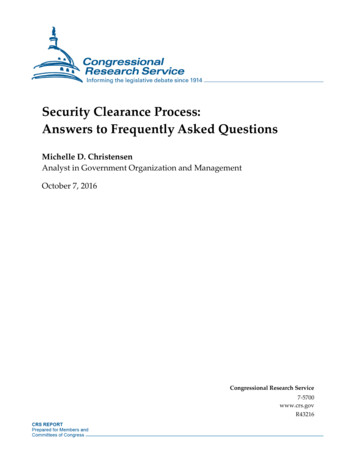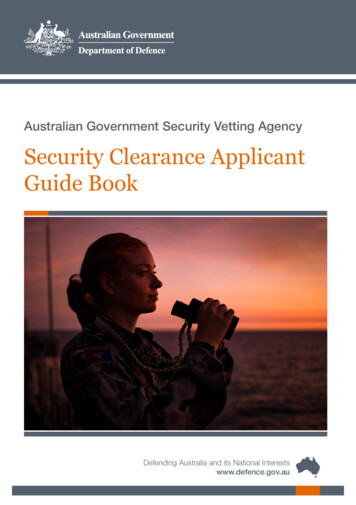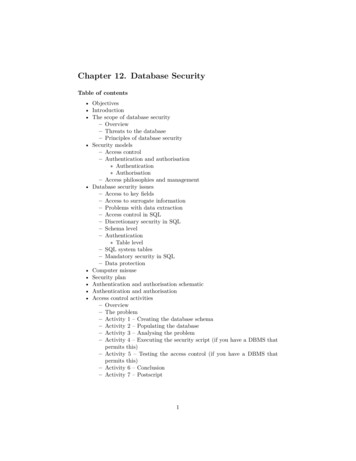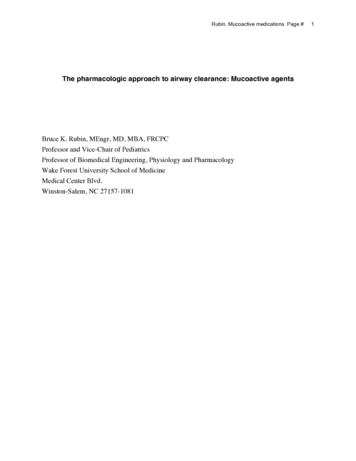
Transcription
Security Clearance Process:Answers to Frequently Asked QuestionsMichelle D. ChristensenAnalyst in Government Organization and ManagementOctober 7, 2016Congressional Research Service7-5700www.crs.govR43216
Security Clearance Process: Answers to Frequently Asked QuestionsSummaryThis report provides a primer on some of the fundamental aspects of the security clearanceprocess, using a “Frequently Asked Questions” format.A security clearance is a determination that an individual—whether a direct federal employee or aprivate contractor performing work for the government—is eligible for access to classifiednational security information. A security clearance alone does not grant an individual access toclassified materials. Rather, a security clearance means that an individual is eligible for access. Inorder to gain access to specific classified materials, an individual should also have a demonstrated“need to know” the information contained in the specific classified materials.There are three levels of security clearances: Confidential, Secret, and Top Secret, whichcorrespond to the levels of sensitivity of the information that a cleared individual will be eligibleto access. In addition, there are two major categories of classified information that requireadditional handling and access restrictions—Sensitive Compartmented Information (SCI), whichincludes intelligence sources, methods, and processes, and Special Access Programs (SAPs),which are highly sensitive projects and programs. These categories exist for classifiedinformation that has been deemed particularly vulnerable. Eligibility standards and investigativerequirements for access to SCI and SAPs are higher than for access to information otherwiseclassified at the same level, which further restricts the number of individuals eligible for access.Federal employees and private contractors must be cleared in order to gain access to classifiedmaterials. An individual may not obtain or initiate a security clearance on his or her own. Asponsoring federal agency initiates the process and will make the final security clearancedetermination based on a background investigation.Although the process involves a number of stages, the key steps to obtaining and maintaining asecurity clearance are (1) agency sponsorship and submission of clearance application materials;(2) a background investigation, the extent of which may vary by level of clearance; and (3)adjudication to determine whether an individual is deemed eligible for access. Adjudication andfinal clearance determinations are generally handled by the sponsoring agency. To maintain asecurity clearance, an individual is also subject to periodic reinvestigations and, more recently,continuous monitoring and evaluation of his or her background.Previously, the Office of Personnel Management, Federal Investigative Services (OPM-FIS)oversaw approximately 95% of all background investigations. On October 1, 2016, PresidentObama transferred responsibility for investigative work and related services from OPM-FIS to thenewly established National Background Investigations Bureau (NBIB). Like OPM-FIS, the NBIBconducts some of the investigative work itself and contracts the rest out to private firms.Typically, the costs of a background investigation, including background investigations of privatecontractors, are paid for by the requesting agency. While the final determination to grant or denya security clearance is typically made by the requesting agency, with certain exceptions a securityclearance granted by one agency must be accepted by other agencies. It is difficult, however, todetermine the degree to which reciprocity occurs between agencies.Congressional Research Service
Security Clearance Process: Answers to Frequently Asked QuestionsContentsIntroduction . Error! Bookmark not defined.What Is a Security Clearance? . Error! Bookmark not defined.What Is the Difference Between a Security Clearance and a Suitability Check?Error! Bookmark not defined.What Are the Levels of Security Clearances? . Error! Bookmark not defined.Who Is Eligible to Obtain a Security Clearance? . Error! Bookmark not defined.Can an Individual Obtain a Security Clearance on His or Her Own?Error! Bookmark not defined.Are Constitutional Officers (e.g., the President, Members of Congress) Required to Holda Security Clearance to Access Classified Information? . Error! Bookmark not defined.Are Congressional Staff and Judicial Staff Required to Hold a Security Clearance to GainAccess to Classified Information? . Error! Bookmark not defined.How Many Individuals Hold Security Clearances in Total and at Each Level?Error! Bookmark not defined.What Are the Major Aspects of the Security Clearance Process? . Error! Bookmark not defined.Are Private Contractors Subject to the Same Clearance Process as Direct GovernmentEmployees? . Error! Bookmark not defined.Which Agencies Are Responsible for Conducting Background Investigations?Error! Bookmark not defined.Who Pays for Background Investigations? . Error! Bookmark not defined.On Average, How Long Does it Take to Obtain a Security Clearance?Error! Bookmark not defined.Are There Guidelines or Standards for Approving, Denying, or Revoking a SecurityClearance? . Error! Bookmark not defined.Can the Outcome of a Security Clearance Determination Be Appealed?Error! Bookmark not defined.May a Security Clearance Granted by One Agency Be Accepted by Other Agencies?Error! Bookmark not defined.TablesTable 1. Security Clearances Approved and Total Clearances Held as of FY2012 . 6AppendixesAppendix. Additional CRS Products on Security Clearances and Protection of ClassifiedInformation . Error! Bookmark not defined.ContactsAuthor Contact Information . Error! Bookmark not defined.Congressional Research Service
Security Clearance Process: Answers to Frequently Asked QuestionsIntroductionThe security clearance process is designed to determine the trustworthiness of an individual priorto granting him or her access to classified national security information. The process has evolvedsince the early 1950s, with antecedents dating to World War II.1 This report highlights some of thefundamental aspects of the process by providing answers to frequently asked questions.2What Is a Security Clearance?A security clearance3 is a determination that an individual—whether a federal employee or aprivate contractor—is eligible for access to classified national security information.4 A securityclearance may only be granted by a federal agency, and generally only upon completion of abackground investigation. Using information obtained during the background investigation, theagency will make a determination as to the character and trustworthiness of the individual, anddecide if he or she will be eligible for access to classified national security information.A security clearance alone does not grant an individual access to specific classified materials.Rather, a security clearance means that an individual is eligible for access. In order to gain accessto specific classified materials, an individual should also have a demonstrated “need to know” theclassified information for his or her position and policy area responsibilities. In addition, prior toaccessing classified information, an individual must sign an appropriate nondisclosureagreement.51Executive Order 10450, “Security Requirements for Government Employment,” 18 Federal Register 2489, wasissued by President Eisenhower on April 27, 1953. E.O. 10450 established that “the appointment of each civilianofficer or employee in any department or agency of the government shall be made subject to investigation.” While E.O.10450 has been amended by subsequent executive orders, it has never been revoked and remains in effect.2Generally, this report will speak about the security clearance process broadly. Where appropriate, any differences inthe process that result from variances in the levels of security clearance will be noted. For example, the backgroundinvestigation (and associated cost) will vary based on the level of security clearance being sought. These differences arediscussed later in the report, under the sections titled “What Are the Major Aspects of the Security Clearance Process?”and “Who Pays for Background Investigations?”.3The term security clearance is not defined in statute. This definition is derived from executive orders, statutes, anddirectives where the term security clearance is used but not defined.4The government also issues security clearances (also referred to as facility clearances) to non-government facilities,such as university laboratories or commercial production facilities, within which contract work for the government isperformed. The procedures and policies for granting facility clearances are outside the scope of this report. It isimportant to note, however, that each individual who performs work within a cleared facility must hold a securityclearance if the work requires access to classified information. For information about the facility clearance process, seethe Department of Defense (DOD), Defense Security Service’s publications “Checklist for a New Facility Clearance”and “Facility Clearance Process FAQs,” at http://www.dss.mil/isp/fac clear/fac clear.html.5For example, see Standard Form 312, “Classified Information Nondisclosure Agreement,” at ngressional Research Service1
Security Clearance Process: Answers to Frequently Asked QuestionsWhat Is the Difference Between a SecurityClearance and a Suitability Check?A security clearance, as noted above, is designed to determine eligibility for access to classifiedinformation. A suitability check (or suitability determination), may involve many of the sameinvestigative elements as a security clearance investigation. A suitability check, however, isdesigned to determine an individual’s suitability for employment or appointment to certain federalpositions.6 Unlike a security clearance, a suitability determination does not convey access toclassified information.7What Are the Levels of Security Clearances?The levels of security clearances correspond to the levels of sensitivity of the information thatcleared individuals will be eligible to access.8 The three levels, in ascending order, are Confidential, the unauthorized disclosure of which would “cause damage to thenational security”;Secret, the unauthorized disclosure of which would “cause serious damage to thenational security”; andTop Secret, the unauthorized disclosure of which would “cause exceptionallygrave damage to the national security.”9In addition, there are two major categories of classified information that are commonly associatedwith the Top Secret level: Sensitive Compartmented Information (SCI), which refers toinformation involving intelligence sources and methods,10 and Special Access Programs (SAPs),which refers to highly sensitive policies, projects, and programs.11 These categories exist forclassified information that has been deemed particularly vulnerable. Eligibility standards andinvestigative requirements for access to SCI and SAPs are higher than for other information65 C.F.R. §731.101.5 C.F.R. §731.202 contains the criteria for making suitability determinations.8The level at which a specific piece of information is classified (i.e., Confidential, Secret, or Top Secret) is determinedby the agency or agencies that maintain “ownership” of the information. While guidelines exist for determining thelevel at which certain information should be classified, there may be dissimilarities in the types of information thatdifferent agencies classify at each level. Consequently, there may be differences in the types of positions that eachagency would categorize as requiring a “Confidential,” “Secret,” or “Top Secret” level clearance.9Executive Order 13526, “Classified National Security Information,” 75 Federal Register 707, December 29, 2009.10Office of the Director of National Intelligence, Deputy Director of National Intelligence for Policy, Plans, andRequirements, 2009 National Intelligence: A Consumer’s Guide, April 2009, p. 83, at , SCI and SAPs are associated with the “Top Secret” clearance level, though DOD regulations suggest thatat least some SAPs may be classified at the “Secret” level. Department of Defense, Special Access Program (SAP)Security Manual, Volume II: Personnel Security, DOD Manual 5205.07-V2, November 24, 2015, p. 8, at http://dtic.mil/whs/directives/corres/pdf/520507 vol02.pdf; Department of Defense, Special Access Program (SAP) Policy, DODDirective 5205.07, July 1, 2010, p. 19, at 07p.pdf. Also see U.S.Army, Special Access Programs (SAPs) and Sensitive Activities, Army Regulation 380-381, April 21, 2004, athttp://www.apd.army.mil/jw2/xmldemo/r380 381/head.asp.7Congressional Research Service2
Security Clearance Process: Answers to Frequently Asked Questionsclassified at the same level, which further restricts the number of individuals that are eligible foraccess.12Who Is Eligible to Obtain a Security Clearance?An individual who is performing work for the federal government—whether that individual is adirect government employee or a private contractor—may be eligible to obtain a securityclearance if his or her work requires access to classified materials. With certain limitedexceptions,13 an individual must hold a security clearance in order to gain access to classifiedmaterials.Generally, only U.S. citizens are eligible to obtain a security clearance.14 Under Executive Order12968, with limited exceptions,eligibility for access to classified information shall be granted only to employees who areUnited States citizens for whom an appropriate investigation has been completed andwhose personal and professional history affirmatively indicates loyalty to the UnitedStates, strength of character, trustworthiness, honesty, reliability, discretion, and soundjudgment, as well as freedom from conflicting allegiances and potential for coercion, andwillingness and ability to abide by regulations governing the use, handling, andprotection of classified information.15Can an Individual Obtain a Security Clearance onHis or Her Own?An individual may not obtain or initiate a security clearance on his or her own. An individualseeking employment with the federal government, or who wishes to do work as a contractor forthe government, may be interested in obtaining a security clearance on his or her own, believingthat holding a security clearance may expedite the hiring process, or provide him or her with anadvantage when competing for government contracts. Yet, only a sponsoring agency may initiatethe security clearance process.1612Individuals seeking access to SCI or SAPs are typically subject to additional clearance procedures. See ExecutiveOrder 12958, “Classified National Security Information,” as amended, 60 Federal Register 19825, April 17, 1995; andOffice of the Director of National Intelligence, Personnel Security Standards and Procedures Governing Eligibility forAccess to Sensitive Compartmented Information and Other Controlled Access Program Information, October 1, 2008,at http://www.dni.gov/files/documents/ICD/ICD 704.pdf.13See the section of this report titled “Are Constitutional Officers (e.g., the President, Members of Congress) Requiredto Hold a Security Clearance to Access Classified Information?”.14Under “compelling” circumstances, an agency may grant limited access to non-U.S. citizens who possess a specialexpertise and “only if the prior 10 years of the subject’s life can be appropriately investigated.” Executive Order 12968,“Access to Classified Information,” 60 Federal Register 40245, August 2, 1995.15Ibid. Under “exceptional circumstances” an individual may be granted temporary access to classified informationprior to the completion of an investigation.16A sponsoring agency may, however, initiate the security clearance background investigation process for a newgovernment employee prior to his or her start date. Generally, the background investigation for a new governmentemployee begins after the agency extends a conditional offer of employment to the selectee. Office of PersonnelManagement, Hiring Elements End-to-End Hiring Roadmap, 2011, p. 8, ongressional Research Service3
Security Clearance Process: Answers to Frequently Asked QuestionsAccording to the Office of Personnel Management (OPM), “clearances are based oninvestigations requested by Federal agencies, appropriate to specific positions and their duties.Until a person is offered such a position, the government will not request or pay for aninvestigation for a clearance.”17Are Constitutional Officers (e.g., the President,Members of Congress) Required to Hold a SecurityClearance to Access Classified Information?Security clearances are not mandated for the President, Vice President, Members of Congress,Supreme Court Justices, or other constitutional officers. The criteria for election or appointmentto these positions are specified in the U.S. Constitution, and except by constitutional amendment,no additional criteria (e.g., holding a security clearance) may be required.18 Further, “by traditionand practice, United States officials who hold positions prescribed by the Constitution of theUnited States are deemed to meet the standards of trustworthiness for eligibility for access toclassified information.”19Additionally, as Commander-in-Chief, the President has the authority to establish the standardsfor access to classified national security information. This authority is typically exercised throughthe issuance of executive orders. Executive Order 13467, which covers suitability checks andsecurity clearances for federal employees, applicants, and contractors, includes a determination ofwhich executive branch individuals are covered and which are exempted.‘Covered individual’ means a person who performs work for or on behalf of theexecutive branch, or who seeks to perform work for or on behalf of the executive branch,but does not include:(i) the President or (except to the extent otherwise directed by the President) employeesof the President under section 105 or 107 of title 3, United States Code; or(ii) the Vice President or (except to the extent otherwise directed by the Vice President)employees of the Vice President under section 106 of title 3 or annual legislative branchappropriations acts.2017See tigations/.For example, qualifications for Members of Congress may be found in Article I, Section 2, clause 2, of the U.S.Constitution, and qualifications for President may be found in Article II, Section 1, clause 5. Also see Powell v.McCormack, 395 U.S. 486 (1969).19Information Security Oversight Office (ISOO), Classified Information Nondisclosure Agreement (Standard Form312) Briefing Booklet, Spring 2001, p. 66, at m-312.pdf. ISOOnotes, however, that Members of Congress, as constitutionally elected officials, are not exempt from the “need-toknow” requirement, and might not have unlimited access to all classified information if such access is not required.Instead, ISOO writes that “[Members] are not inherently authorized to receive all classified information, but agenciesprovide access as is necessary for Congress to perform its legislative functions, for example, to members of acommittee or subcommittee that oversees classified executive branch programs.”20Executive Order 13467, “Reforming Processes Relating to Suitability for Government Employment, Fitness forContractor Employees, and Eligibility for Access to Classified National Security Information,” 73 Federal Register38103, July 2, 2008. The statutory provisions cited in the order refer to sections of law that provide for the appointmentof certain personnel within the Executive Office of the President.18Congressional Research Service4
Security Clearance Process: Answers to Frequently Asked QuestionsAre Congressional Staff and Judicial Staff Requiredto Hold a Security Clearance to Gain Access toClassified Information?Congressional staff and judicial staff are required to hold security clearances to gain access toclassified information. The requirements are established, for the most part, by public laws,congressional rules, and judicial procedures.For example, the Rules of Procedure of the U.S. Foreign Intelligence Surveillance Court statesthat “each member of the Court’s staff must possess security clearances at a level commensurateto the individual’s responsibilities.”21 Within Congress, the Office of House Security and theOffice of Senate Security require that staff obtain the appropriate security clearances and signnondisclosure agreements in order to be eligible for access to classified national securityinformation.22How Many Individuals Hold Security Clearances inTotal and at Each Level?According to the Office of the Director of National Intelligence (ODNI), approximately 4.3million individuals held security clearances (of any level) as of October 1, 2015.23 This includes2,885,570 security clearances at the Confidential or Secret level and 1,363,483 securityclearances at the Top Secret level.24A total of 638,679 security clearances were approved during FY2015.25 This includes 408,262clearances approved at the Confidential or Secret level and 230,417 at the Top Secret level.26 It isimportant to note that the number of security clearances approved in FY2015 includes initialclearances and renewals of existing clearances that were subject to reinvestigation in FY2015. Forthis reason, the number of clearances approved does not reflect the number of new clearancesissued.Table 1 provides a breakdown of these figures by government and contractor employees.21Foreign Intelligence Surveillance Court, “Title II: National Security Information,” in Rules of Procedure, November1, 2010, p. 1, at f.22U.S. Senate, Office of Senate Security (OSS), Security Manual (revised, 2007), p. 8. Also see U.S. House ofRepresentatives, Rule XXIII, clause 1 (114th Congress); and CRS Report RS20748, Protection of ClassifiedInformation by Congress: Practices and Proposals, by Frederick M. Kaiser.23Office of the Director of National Intelligence, 2015 Annual Report on Security Clearance Determinations, January2016, p. 5, at rts%20and%20Pubs/2015Annual Report on Security Clearance Determinations.pdf. The ODNI report consolidates the data on Confidentialand Secret level security clearance determinations, and does not provide separate figures for the two levels.24Ibid.25Ibid., p. 7.26Ibid.Congressional Research Service5
Security Clearance Process: Answers to Frequently Asked QuestionsTable 1. Security Clearances Approved and Total Clearances Held, FY2015Government EmployeesApproved inFY2015Contractor/Other EmployeesTotal as of End ofFY2015Approved inFY2015Total as of End 23,983Top 8,423204,7871,240,630Source: ODNI, 2015 Annual Report on Security Clearance Determinations, pp. 5,7.Notes: Contractor/Other Employees includes figures reported for contractor employees and individuals whocould not be identified as either government employees or contractor employees. The ODNI reportconsolidates the data on Confidential and Secret level security clearance determinations.What Are the Major Aspects of the SecurityClearance Process?Although the security clearance process involves a number of stages, the key steps to obtainingand maintaining a security clearance are pre-investigation, investigation, adjudication, andreinvestigation. Pre-Investigation. During this phase, the agency makes a determination that anemployee or contractor requires access to classified information for thecompletion of his or her duties.27 At the request of the sponsoring agency, theindividual will submit his or her clearance application material (e.g., StandardForm SF86).Investigation. Using the information provided by the applicant in his or herclearance application materials, a background investigation of the applicant isconducted. The background investigation may vary in terms of content, cost, andlength of time for completion depending, in part, on the level of clearance beingsought.28 The National Background Investigations Bureau (NBIB) within OPM isresponsible for overseeing the majority of personnel background investigations.29Adjudication. Once the background investigation is complete, the applicationenters the adjudication phase. During this phase, a determination is made whetherto grant the applicant a security clearance. Generally, this decision is made by thesponsoring agency and is based on the information obtained during thebackground investigation.Reinvestigation. Individuals who hold security clearances are subject to periodicreinvestigations. Previously, the maximum number of years that a securityclearance remained valid was tied to the individual’s clearance level. Forexample, reinvestigations for someone with a Confidential clearance, the leastdemanding, occurred at least once every 15 years; Secret, at least once every ten27This designation applies to the position rather than to a specific individual who holds the position.For example, some but not all background investigations include a polygraph examination.29For additional information, see the section of this report titled “Which Agencies Are Responsible for ConductingBackground Investigations?”.28Congressional Research Service6
Security Clearance Process: Answers to Frequently Asked Questionsyears; and Top Secret, at least once every five years.30 OPM and the Office of theDirector of National Intelligence (ODNI), however, reduced the reinvestigationtimeline to five years for all clearance holders, regardless of access level.31Are Private Contractors Subject to the SameClearance Process as Federal Employees?Private contractors are subject to the same clearance procedures as direct government employees.As noted above, an individual may not obtain or initiate a security clearance on his or her own.The process to obtain a security clearance must be initiated by a sponsoring federal agency. Theprocess differs slightly for an individual who is employed by a company that performs workunder contract with the federal government. First, the contractor must determine whether theemployee requires access to classified information in order to perform the duties of his or herposition.32 The contractor must inform the sponsoring agency (i.e., the “customer” agency forwhom the work is being performed) that the employee requires access to classified materials. Thesponsoring agency will consider the request and then determine whether to initiate the securityclearance process for the employee.33Which Agencies Are Responsible for ConductingBackground Investigations?Previously, the Office of Personnel Management, Federal Investigative Services (OPM-FIS)oversaw approximately 95% of all background investigations.34 On October 1, 2016, PresidentObama transferred responsibility for investigative work and related services from OPM-FIS to thenewly established National Background Investigations Bureau (NBIB). 35 Like OPM-FIS, theNBIB conducts some of the investigative work itself and contracts the rest out to private firms.30P.L. 108-258 at 118 Stat. 3706. OMB Security Processes Review, p. 2.U.S. Office of Personnel Management, Testimony of Beth F. Cobert, Acting Director, Before the House Committeeon Oversight and Government Reform, Hearing on “Security Clearance Reform: The Performance AccountabilityCouncil’s Path Forward”, Washington, DC, February 25, 2016, p. 4, at ility-councils-path-forward.pdf. Also see Office ofManagement and Budget (Performance Accountability Council), Insider Threat and Security Clearance Reform: CrossAgency Priority Goal Quarter Progress Update FY2016 Q1, March 2016, pp. 17, 22, at https://www.performance.gov/node/3407/view?view public#progress-update.32Ibid. Also see DOD Defense Security Service publication “Industrial Personnel Security Clearance Process,” athttp://www.dss.mil/psmo-i/indus psmo-i process applicant.html.33Ibid. In some instances, if the individual is a former government employee or had previously performed work as acontractor for the government, he or she may already hold a security clearance at the necessary level. In such cases, theagency may accept the individual’s existing clearance, or the agency may request an additional backgroundinvestigation. See the section of this report titled “May a Security Clearance Granted by One Agency Be Accepted byOther Agencies?”.34This figure includes non-security clearance background investigations, such those conducted for “suitability checks.”35National Background Investigations Bureau, “Safeguarding Integrity and Transparency: About Us,” athttps://nbib.opm.gov/about-us. Also see Executive Office of the P
Security Clearance Process: Answers to Frequently Asked Questions Congressional Research Service 1 Introduction The security clearance process is designed to determine the trustworthiness of an individual prior to granting him or her access to classified national security information. The process has evolved










